Mayor Sam Adams hosted the Transportation Safety Summit at U of O’s White Stag Building in downtown Portland Tuesday night and a standing-room only crowd of over 200 citizens, advocates and city and state officials showed up.
The event offered an opportunity (albeit short at only two hours) to network, learn about Portland’s transportation safety concerns, and share feedback about how the City should, according to the Mayor’s official invite, “close the gap between the current state of traffic safety in Portland and the desired state.”
“…If we are going to meet that goal of 25% mode share — and for all of you, sort of transportation groupies, that mode share feels good… We’re going to have to work at it.”
— Sue Keil, Director of PBOT
Speaking at the event were Mayor Adams, PBOT Director Sue Keil, Police Chief Rosie Sizer, ODOT Region 1 Director Jason Tell, TriMet GM Fred Hansen, Traffic Division Captain Eric Hendricks Portland Fire Marshall Erin Janssens, and others.
Adams, who is also the Transportation Commissioner, spoke about Portland’s accomplishments and ongoing challenges. He shared stats that tell a story of our roads becoming much safer for all modes in recent years, but then warned of complacency. “I share these accomplishments not so we can rest on our laurels, but to show that progress can be made.” Adams re-iterated that although “it has been controversial,” he has chosen to prioritize safety improvements over “smooth pavement.”
We need more money to save lives, said Adams, and thankfully there’s $300 million in new transportation revenue coming into Oregon due to the passage H.B. 2001 (although Adams said there’s a petition effort afoot to challenge that law). Regardless of budgets, Adams said PBOT relies on partnerships with agencies and citizen groups. “They’re important and they make a difference.”
While Adams’ tone on getting more Portlanders to choose bicycles is hopeful and inspiring, PBOT Director Sue Keil — the person in Portland with the most power to carry out Adams’ vision — has a different tone. After sharing the party line about the importance of safe biking and walking routes for everyone, she spoke about the “serious choices” she has had to make in terms of spending priorities.
Referring to a series of public meetings held prior to last year’s budget talks (at a time when PBOT revenue was in much more dire straits than it is now), she said PBOT has “walked away from residential streets” and instead is focused on “the busy streets, the lifeline routes that carry goods and services to commercial centers.” Below is a partial transcript of the rest of her remarks:
“…If we are going to meet that goal of 25% mode share — and for all of you, sort of transportation groupies, that mode share feels good. But, if we’re going to get to 25% of trips in the next 20 years by bicycle — we’re going to have to work at it. And it’s not just about putting infrastructure out there, although that certainly helps, it is about encouragement and education and getting people who are like me; not the hot-rod teenage male that is the classic, sort of poster child in bicycling… It’s about getting folks to use those bicycle boulevards which are much safer and will really increase the number of people who are cycling.”
It remains to be seen how Keil will balance her priority on “busy streets” while also improving bike boulevards — which are on the same residential streets her bureau has “walked away from,” and that she says are so key to getting people like her on a bike and reaching the 25% mode split goal. Keil also seemed to lament PBOT’s lost revenue due to 100,000 fewer cars being registered in Multnomah County last year — a trend that should be encouraged and celebrated for someone committed to increasing bike mode split.
TriMet GM Fred Hansen’s remarks included a reference to a key safety issue that remains to be solved — the bike/bus leapfrog that happens on streets like North Williams. “Our buses are in direct conflict… with bike lanes. How do we do that [service bus stops] and still be safe.” Hansen said they’re working to identify the top 12 bike-bus conflict locations.
Hansen also shared a troubling stat: 25% of seniors and riders with disabilities cannot access TriMet’s services due to an absence of sidewalks and/or unsafe crossings.
This was the first time I’ve seen the Portland Fire Marshall attend a transportation event. Mayor Adams knows the Fire Bureau is a key player on bike projects. They have final veto power (and have used it in the past) and they figure prominently in bike boulevard plans because some of the traffic calming measures PBOT staff prefer are not welcomed by emergency vehicle operators. Janssens weighed in on that issue: “Our goals have been directly opposed in the past… How do we meet our response time goals and still provide safe routes for bikes?”
After these introductory speeches, attendees broke off into groups according to geographic area. The groups were separated into Portland’s nine neighborhood coalitions and each coalition station had four focus areas; Safe Routes to School, bike safety, pedestrian safety, and high-crash corridors. Each area was staffed with a City employee to explain the issues, answer questions, and write down feedback.
The neighborhood focus stations were buzzing with activity. Citizens could view a map of crash locations and stick post-it notes with their feedback: “There is no reasonable place to get across the highway,” “MLK is very scary,” “Easier crossings of NE 33rd please.”
One person didn’t need a post-it note to make their point. On the crash location map, right on top of the MLK/Grand/Broadway corridor which was nearly solid red with crash incidents, someone had simply drawn a sad face.
In the Southwest Neighborhood section, citizen activist Don Baack told a city staffer that he’d like to see more communication between PBOT and residents before decisions are made.
With all the great discussions happening, it seemed like the event should have ended with everyone reporting back with key insights from their neighborhoods. But instead, the night ended with a short Q & A session.
The first question was about why the City should raise revenue by licensing bikes. Adams replied by saying, “We’ve looked at that a number of times” but that it doesn’t pencil out financially. “It’s not the big money-maker you might expect… it’s not a panacea.” He also pointed out that “Bikes are paying their fare share.”
The next question went to a man who is legally blind. He said some of his friends are “fearful to go out” because they’re afraid someone on a bike will run them over. “Bicyclists have to have some incentive to respect pedestrians,” he said.
North Portland resident and member of the City’s bike advisory committee Shamus Lynskey asked: “What’s the next big idea for how to fund all of these great ideas?” Neither Mayor Adams (who mentioned his effort to find $20 million for bike boulevards in the Bureau of Environmental Services budget) or PBOT Director Sue Keil (who mentioned a pilot VMT tax program) had much of an answer for that one.
Overall, attendees seemed grateful for the event, but it’s clear that these issues deserve much more attention. Hopefully Mayor Adams will share the results of all the neighborhood feedback and provide details on how/if he and PBOT plan to address all the citizen feedback. There was also survey launched prior to this event that was not talked about at the Summit. I’ve asked the Mayor’s Office for results of that and will share them once they become available.



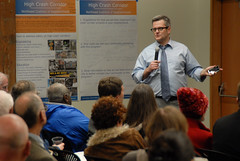
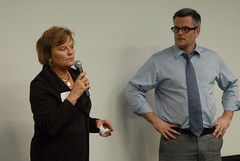

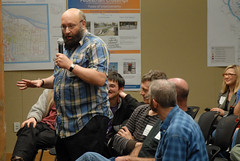
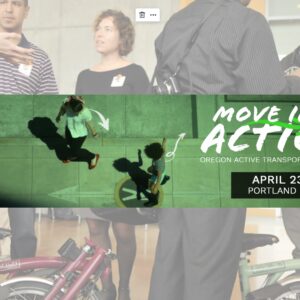
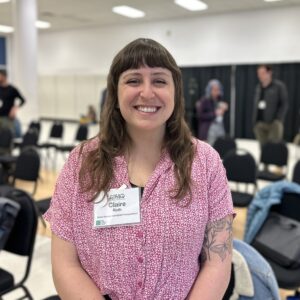
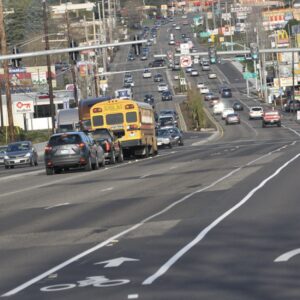
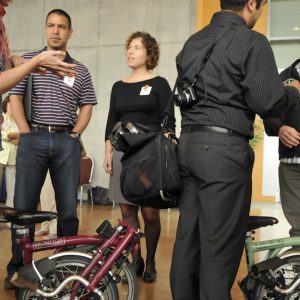
Thanks for reading.
BikePortland has served this community with independent community journalism since 2005. We rely on subscriptions from readers like you to survive. Your financial support is vital in keeping this valuable resource alive and well.
Please subscribe today to strengthen and expand our work.
I must admit that it’s becoming more difficult to be mad at Sam Adams.
Question #1: If the population is supposedly increasing, then why are there fewer cars registered in Multnomah County? More children and/or cyclists?
Question #2: Did anyone ask Fred Hansen about ever-increasing bus fares? I know times are tough, but I also know from their website that Trimet employees have fairly fat salaries. Just saying…..
Nick V,
My hunch is that the bad economy is the reason for fewer cars being registered.
And no, no one asked Hansen about fare increases. One guy did plead with him to not close a particular bus route though.
Thanks for the recap Jonathan.
TYPO: there are seven district coalitions, not nine.
*Thanks Steve, correction made — Jonathan*
I was happy to see this happen, but I too felt like the event was way to short. The breakout groups only had enough time for the presenters to present before they moved on, not much opportunity for discussion or problem-solving between that and a few monopolizing voices. This really should be a weekend-long event in order for it to truly be a summit.
Re: the q&a bit:
I have noticed that people seem to be more afraid of being hit by a bike than a car…when the opposite is true.
That makes me sad. =(
I’m grateful that the city recognizes the importance of safe streets.
I’ve asked Mayor Adams to devote an entire day to this next year, I suggest you all do the same. There was a lot of great energy in the room and the shortness of the event left much to be desired.
Sue Keil seems confused. This city won’t be truly safe for cyclists until the ‘busy streets’ as well as the residential streets, are redesigned to safely accomodate cyclists, who want to access the same commercial districts and destinations as motorists do.
I’m not sure, KJ (#5), whether you’re referring specifically to blind people (which is what the questioner was referencing). The blind friend I have is definitely more afraid of being hit by a bike than a car, and she tells me that others also blind feel the same (but that may be her perspective coloring her perception). The main problem is that you can’t really hear a bike approaching, but you can hear a car approaching. For the visually impaired, this makes all the difference. My friend lives right between Vancouver & Williams, which adds to her apprehension — there are just so many bikes around, everytime she leaves her apartment.
Also, what is the source of your contention that “the opposite is true” (implying that more people are hit by cars than by bikes)? We have pretty decent data on how many people get hit by motorists, but I wasn’t aware of any good, reasonably accurate or comprehensive data on how many people get hit by cyclists. Do you have some?
Michel: I didn’t catch the reference to the blind, apologize for that, I understand the concern there. I can also see how this would be especially true for hybrid cars as well.
I was commenting I have herd the sentiment a lot lately. And that cars are far more dangerous to peds than bikes. Even in a collision. (not to say there aren’t bike-ped deaths, there have be a few I have read about..i think one in NY last year?)
I wish we did have data, but I have not seen any either. It may not exist. I do think that pedestrians and cyclists are more maneuverable and have a faster reaction time than someone driving. Someone correct me if my physics are wrong but, A cyclist is able to react to thier enviorment faster, because they are slower and lighter than a car.
Bikes have more general dexterity. They also occupy less space and pedestrians are easy to maneuver around, even when unpredictable. (At least I find this to be true.)
I do think they are rare. (bike-ped collisions, compared to ped-car and bike-bike…I am cool with being wrong on that, since I have no way of really knowing.)
This statement is purely option based on personal experience: I think unless you are truly oblivious or actually TRYING to hit a pedestrian, most ped-bike collisions are pretty avoidable.
Basically, I am sad that people are afraid of bikes. When I do think that cars are the bigger worry, in general.
I also do wish more cyclists behaved predicably and yielded to peds, it’s one my biggest pet peeves…
This was my first Transportation Summit. I was very impressed overall, but wished I had had a little more background on the program going into it.
In particular, we “bikey” folks should have had at least one person pop their hand up in the air at the beginning of the 15 min open comment forum and give some Love for the Bike Plan. As it was, the only bike comments were “those things need to be registered” and “I feel like I’m going to get run over when I’m walking on the sidewalk” types.
If we want to see the 2030 Bike Plan built, built quickly, and built well, we need to show broad-based support for it.
And someone should have been handing out “Build it” buttons to everyone who walked in with a helmet. BTA, any buttons left?
Thanks for the comprehensive coverage, Jonathan!
Ted Buehler
Tom Vanderbilt wrote an excellent blog post about the relative dangers of bikes and cars, and why people tend to overrate the danger posed by bikes:
http://www.howwedrive.com/2009/03/16/the-phantom-menace/
Even so, taking into account what I just read in the comments here, I can totally imagine how a fast-moving bike would – because it moves silently – be particularly startling to the visually impaired. Especially considering how some of us on bikes tend to leave too little buffer between ourselves and people on foot.
That aside, the “bikes are a menace!” sentiment seemed popular among more than one summit attendee.
In response to that sentiment, I would hope City officials might start responding with the same reasonable observation Vanderbilt makes: bikes pose only a tiny sliver of the danger posed by cars. It’s just that the way we perceive danger tricks us into focusing on, and amplifying that sliver.
It seems like the biggest hurdle is funding. We can talk about what we need all the time, but how do we get it? We’re just shifting funds from one service to another. There are opportunity costs associated with these decisions, as Sue mentioned, unless we come up with a “safer routes” funding source…
Spencer, good point. Just remembering to slow down and use a bell around peds is simple and effective. Maybe we need to revive the bell giveaway program.
It was a good summit and, due to the fast pace, if you stayed focused you had the opportunity for a lot of input.
Thanks for the diligent reporting, Jonathan.
Jonathan,
As always, thanks for being there and reporting back. I too, felt the evening was far too short and was confused by the way the questions were worded. “How can you and your community group support the city in getting your needs met?” Huh?
I get it that they need help, can’t invest more $$ in things than they currently do, but it seems pretty simple to me . . . develop lines of communication that are fast, clean, and updated in the moment. Use the internet to the extent it can be used.
The City can continue to advertise, with a ton of lead time, when they are planning anything new, when they need Citizen Advisory Boards, etc and we will come forward and serve on those. They can use a map with “pins” to give updates on projects at specific locations (save staff time in taking phone calls, think Obama Campaign. He used it and it was an effective and extremely easy system to use). And, they could offer up a slate of Public Speakers for those of us out in the community to access for community education. Perhaps some of our most vocal commuters of each type of mode would be willing to be on that slate of speakers.
What if we focused heavily on education and awareness for one year? I mean everywhere, in every form of media, on every week and every day. Would people get it then?
The “IT” being, we need to share. We all need to share. We needed to share in grade school and we need to share now.
Your Free-Range Commuter,
Kim
My wife has a scar on her arm from where a cyclist hit her down by PSU. She stepped out of the parking garage and into a crosswalk where the cyclist glanced of of her.
He turned around, yelled “Watch where you’re going!” and rode off.
It’s acecdotal, I know… but since it was MY WIFE I think everybody should care anyway!
I think the studies Vanderbilt wrote about in “Traffic” that showed people overwhelmingly tend to identify people riding bikes as people (“he” or “she”) while identifying people driving cars as objects (“the car” or “it”) also helps explain the tendency to overrate the threat posed by bicycles. Generally speaking, we are more apt to attach blame to the actions of people than to the actions of objects, and therefore inflate the risk we perceive as being posed by people.
Nevertheless, Vanderbilt is talking about the risk of being killed, or at least seriously injured. I think what most people are afraid of is being hit. I know when I got hit by a cyclist (in NYC, where I was living), I was surprised at how many people told me (when I had to explain my cuts and bruises) their own stories of how they’d been hit by a cyclist. Maybe that’s a peculiarity of NYC’s density, but I was certainly unaware of just how many people I knew had had run-ins with bicycles until it happened to me. My injuries didn’t require medical attention, the collision was never reported, no one happened to mention reporting their own collisions — so I’m not sure on what Vanderbilt is basing his contention that “the injury numbers are equally skewed.” Maybe in London, and likely elsewhere in Europe (where people ride more slowly and cautiously than we do here), but not necessarily in the U.S. and I very much doubt in NYC.
In Portland, one problem that leads to the “bikes as menace” mindset is that bikes and peds are so often in much closer proximity than peds usually are with cars. Even for the visually unimpared, it is startling to be passed closely from behind by a fast-moving vehicle, especially when you can’t hear it coming. Even in situations where it might not be particularly dangerous, it is easy to perceive it as menacing. I don’t think this problem will be alleviated until we get more and better separated facilities for the two modes of travel.